Lafayette Hall (1880-1960)
Introduction
Text-to-speech Audio
Lafayette Hall served as a dormitory hall for Girard College students and staff between 1882-1957. The dormitory was originally known as Building #8 and was later renamed in 1927 after American Revolutionary War hero Lafayette. The building was designed in the Collegiate Gothic architectural style by Girard College alumnus and architect James H. Windrim. Lafayette Hall housed an average capacity of 400 students, most of whom were older middle school youth. In its 80 years of service, Lafayette featured a grand dining hall that seated over 1000 students and, later on, held the Student Center. Lafayette Hall was partially closed in 1947 before being completely closed as a student dormitory in 1957 due to declining enrollment. Student activities continued to be held in Lafayette Hall until it was demolished along with the neighboring Good Friends Building in 1960. A soccer field was built on the site, which continues to exist today.
Images
1893 photo of Building #8, later known as Lafayette Hall.
.jpg)
1888 illustration of Lafayette Hall.
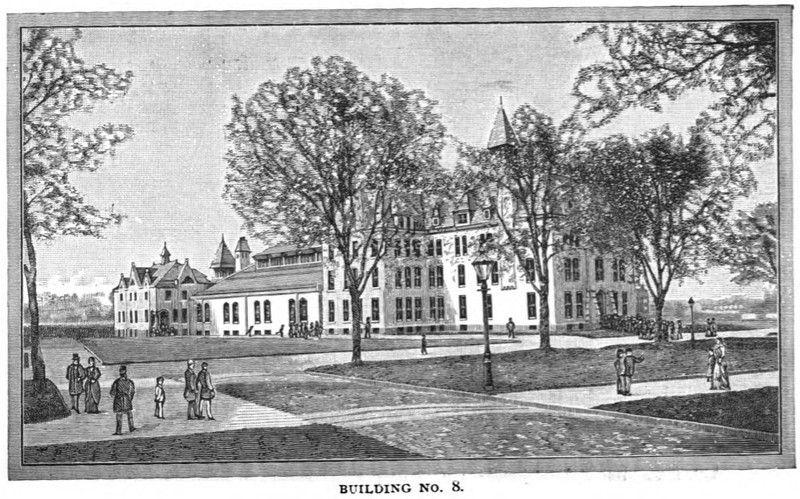
1888 illustration of Lafayette's dining hall.
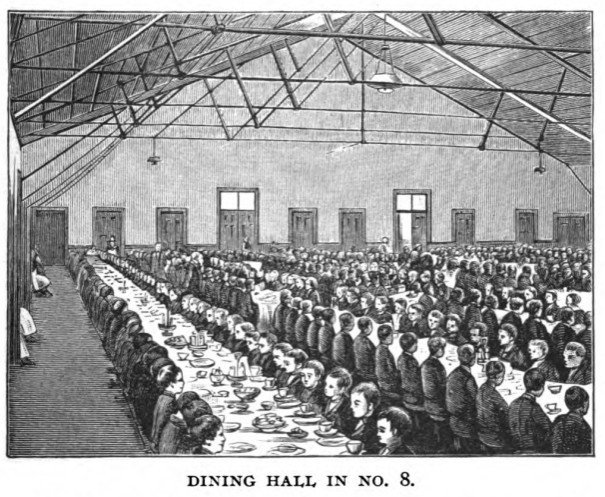
Stereograph of students seated at dining tables in Lafayette’s dining hall.
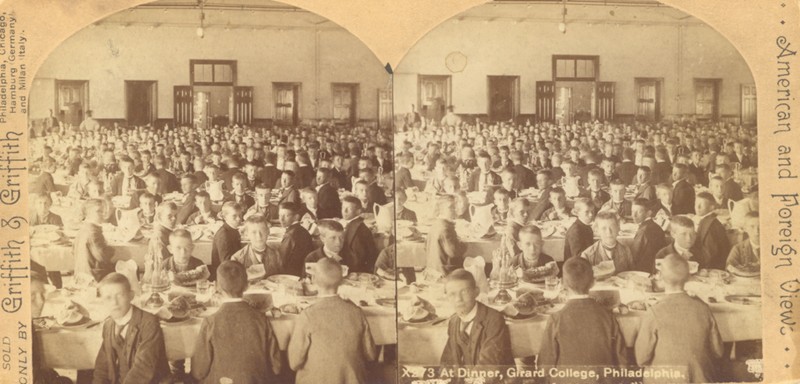
Rooftop view photo of Good Friends Building and Lafayette Hall in 1890.
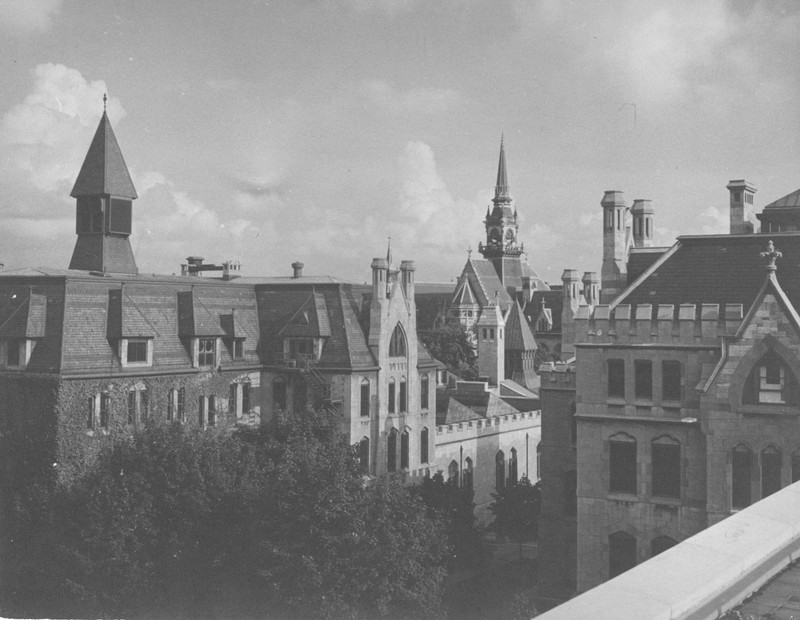
Photo of Good Friends Building and Lafayette Hall after a snowy day.
%20(2).jpg)
Color photo of Good Friends Building and rear structure of Lafayette Hall before 1960 demolition.
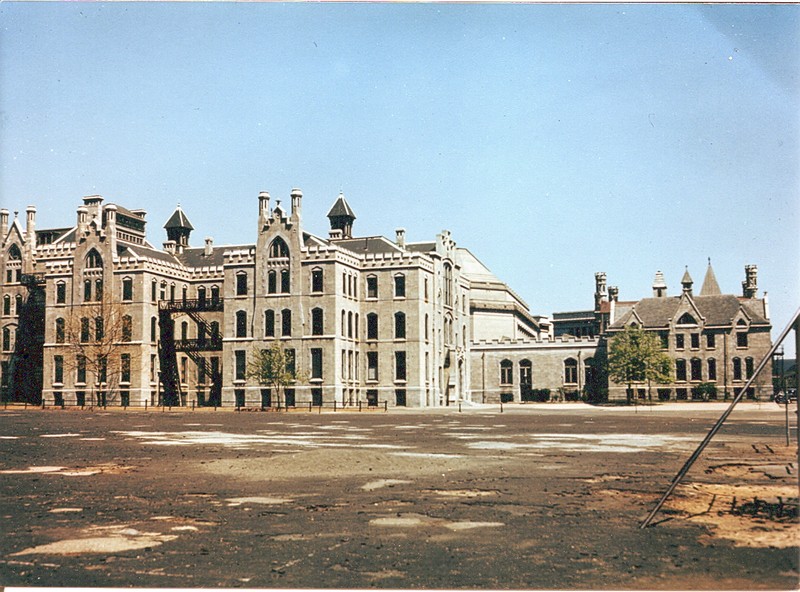
Backstory and Context
Text-to-speech Audio
As student enrollment gradually approached 1000 students in the 1880s, Girard College urgently needed more dormitory space to accommodate the hundreds of applicants awaiting admission. A new dormitory building was proposed to be built towards the west end of campus, south of the campus main road. Building #8 was designed in the Collegiate Gothic style popular for 19th century campuses by James H. Windrim, a Girard College alumnus and the appointed architect for the Board of Directors of City Trusts. Windrim also designed other Gothic campus buildings during his tenure, including the first Chapel and Buildings #7, #9, and #10. Construction for Building #8 began in 1880 and it opened as a dormitory for middle school students in 1882. When all of the numbered buildings on campus officially received names in 1927, Building #8 was renamed as Lafayette Hall in honor of the American Revolutionary War hero Marquis de Lafayette. Stephen Girard, the school’s founder, met Lafayette on the Frenchman’s grand tour of the United States in 1825.
During its 80 years of service, Lafayette Hall was located to the left of Building #9, which would be known as the Good Friends Building. A connecting corridor was built between Lafayette Hall’s dining rooms and the Good Friends Building, which allowed students to travel between the two dormitories. Lafayette Hall’s building exterior was covered in white marble, with the exterior frame of the doors and windows lined in blue marble. It had four floors in total, which included a basement and three stories topped by a mansard roof. The front structure consisted of the dormitory section rooms, student dorms, residential staff’s bedrooms, living rooms, recreational rooms, storage rooms, a dorm library, and a small front parlor. The basement held the bathing pools and wash basin rooms, along with the Battalion’s armory and drill rooms before the 1927 Armory was built. Toilets were located in a separate outside unit until they were installed in the dormitory building in 1952. The building’s rear structure contained the central kitchen, scullery, grand dining hall, staff dining rooms, and domestic staff’s bedrooms.
Lafayette was most notable for its massive 120-feet by 95-feet dining hall that could seat over 1000 individuals. This was intended to provide dining for all middle school and high school students. Its maximum capacity was pushed to serve an additional 200 students in the 1920s due to the growing student population. Between the 1920s and 1930s, Girard College undertook efforts to reorganize residential life into small or family-style unit arrangements and as a result, Lafayette’s dining hall was remodeled and divided into 4 separate dining rooms in 1928. About half of the middle school students continued to eat in Lafayette while the rest were assigned to the newly built Dining and Services Building. After the staff dining rooms closed in 1944 due to a shortage of domestic staff, the residential and domestic staff of Lafayette Hall also ate their meals in the student dining rooms.
Lafayette Hall primarily housed students from the upper middle school grades who were around the ages of 12 and 13. During periods of overcrowding in the early 20th century, younger high school students between ages 14 and 15 were also assigned to this dormitory building. Students were grouped into four dormitory sections of about 40 students each, for an average capacity of 160 students. Originally, female residential staff known as governesses supervised the students, but beginning in 1937, they were replaced by male housemasters, who were believed to be more capable of managing young adolescent boys. Lafayette Hall students were originally assigned to the nearby Good Friends playground for outdoor recreation, but were relocated to the Mechanical School playground in 1937 to decrease playground overcrowding. Access to more open space allowed housemasters to organize team sports and athletic competitions among the students of Lafayette Hall. The housemasters also established a Boy Scout troop for the students of both Good Friends and Lafayette, taking them on hikes and walks in the park during the weekends. Inside the dormitory, students had access to photographic darkrooms as well as a workshop in the basement for arts and crafts and wood-working projects. Beginning in the 1940s as a result of a domestic staff shortage, students were required to participate in the Student Work Program and fulfill many of the domestic and cleaning duties for their own dormitory.
By the 1940s, the 60-year old Lafayette Hall required major renovations. However, the interior layout of the outdated dormitory building was considered too expensive to repurpose. In 1945, Girard College made plans to demolish both Lafayette and Good Friends in order to build a larger dormitory building, with small unit dorm rooms of 2-4 students, but declining postwar enrollment led the school to abandon this idea. The rear building structure of Lafayette Hall was closed in 1947 and the entire building closed as a dormitory in 1957. The Student Center, which included a student-run store and extracurricular space, had been relocated from Founder’s Hall to Lafayette’s former dining hall in 1956 and remained there until the building was demolished in 1960. A soccer field was built on top of the demolished site a year later. The soccer field, along with an encircling running track, continues to exist today.
Sources
Chronology of GIRARD COLLEGE, 1832-2016. June 2016. Compiled by Gil Bunker, Thomas J. DiFilippo, Walter C. Gold, and Cheesman A. Herrick for the Founder's Hall collections in Girard College.
DiFilippo, Thomas J. Stephen Girard, The Man, His College and Estate. Edition 2nd. 1999. Accessed August 24 2020. http://www.girardweb.com/girard/contents.htm.
Girard College, Annual Reports of the Board of Directors of the Girard College of Orphans. Philadelphia, PA.
Girard College. President's Reports and Catalogue of Pupils - Girard College, The City of Philadelphia, Trustee. Philadelphia, PA.
Herrick, Cheesman A. History of Girard College. Philadelphia, PA. Girard College, 1927.
Scattergood, David. Hand Book of Girard College. Illustrated. Philadelphia, PA. D. Scattergood, 1888.
Girard College Historical Collections.
Scattergood, David. Hand Book of Girard College. Illustrated, Page 20. Philadelphia: D. Scattergood, 1888.
Scattergood, David. Hand Book of Girard College. Illustrated. Philadelphia: D. Scattergood, 1888.
Girard College Historical Collections.
Girard College Historical Collections.
Girard College Historical Collections.
Girard College Historical Collections.
